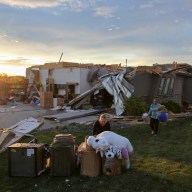WINNIPEG – Manitoba’s First Nations communities say they can’t afford to wait for government help with swine flu and are instead turning to corporations to help buy vital supplies to prevent the virus from spreading.
Grand Chief Ron Evans with the Assembly of Manitoba Chiefs said Wednesday that they’re asking for corporate donations to pay for 15,000 swine flu kits for flu-stricken communities. They need to raise $1.5 million for the kits, which will include hand sanitizer, masks and anti-bacterial tissue, Evans said.
“We can’t wait,” he said. “We have to start doing something.”
Health Canada came under fire recently for delaying a shipment of hand sanitizers to remote northern First Nations because they contained alcohol. The Assembly of Manitoba Chiefs says some communities had to wait almost a month before they got the sanitizers they needed.
First Nations are caught in the middle of a jurisdictional dispute between the province and the federal government over who bears responsibility for health care on reserves, Evans said.
First Nations can’t afford to get bogged down in bureaucracy when people are dying from the virus, he added.
“This is no time for jurisdictional arguments,” he said. “This is something that needs to be done.”
The assembly has already received a $10,000 donation from CIBC and hopes to raise more in meetings with other corporate partners, Evans added.
Manitoba Health Minister Theresa Oswald has said the federal government takes the lead in situations like this but the province has been playing an important supporting role by supplying doctors, nurses and other supplies. So far, the province says it has provided First Nation communities with 850 litres of hand sanitizer, 45 treatment courses of the antiviral drug Tamiflu, more than 2,600 respirator masks and 9,000 surgical masks.
Manitoba’s aboriginal population has been hit hard by swine flu. Of the province’s most severe cases, the majority of patients in intensive care have been aboriginal.
While Evans said the H1N1 flu has affected 20 people in every 100,000 in Canada, he said that number jumps to 135 in 100,000 for Manitoba’s First Nations.
“It’s really affecting our community and yet we only make up 10 per cent of the population here,” said Evans, adding the federal government should be doing more.
“The statistics right now should be cause for them to be more concerned and do all they can to provide the communities with what they need.”
Health Canada says it has provided support to afflicted First Nation communities. In an emailed statement late Wednesday, the department said it has “shipped antivirals to affected communities.”
Nursing stations are staffed round the clock and they have “adequate supplies of medical and personal protective equipment,” the statement said.
Additional supplies and staff are sent when needed, the department said.
Many of the province’s flu patients have been airlifted from a cluster of reserves in a remote area 500 kilometres northeast of Winnipeg that has fewer than 10,000 residents.
Aboriginal leaders have said poor living conditions, including cramped housing and lack of clean water, have made some reserves a “breeding ground” for the virus.
First Nations want to have the flu kits out before the virus flares up again, as some predict it will in the fall, Evans said.
“It gets more expensive to treat a sick person than to keep one healthy.”
Manitoba reported 44 new cases of H1N1 on Wednesday, bringing the provincial total up to 831. Six people in the province have died of flu-related illness.
















